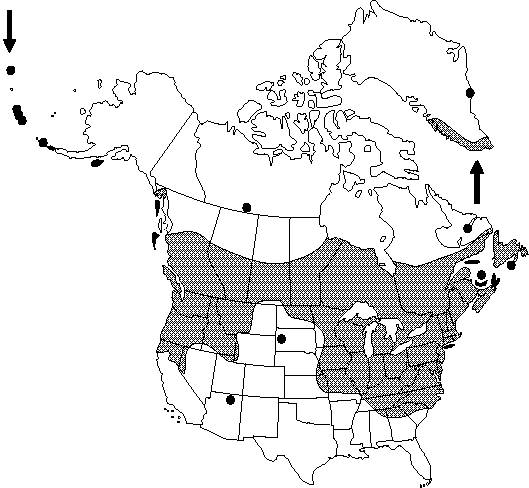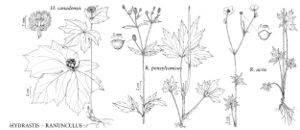Ranunculus acris
Sp. Pl. 1: 554. 1753.
Stems erect from short caudex or rhizome, never rooting nodally, hispid, strigose, or glabrous, base not bulbous. Roots never tuberous. Basal leaf blades pentagonal in outline, deeply 3-5-parted, 1.8-5.2 × 2.7-9.8 cm, segments 1-2×-lobed or -parted, ultimate segments narrowly elliptic or oblong to lanceolate, margins toothed or lobulate, apex acute to rounded. Flowers: receptacle glabrous; sepals spreading, 4-6(-9) × 2-5 mm, hispid; petals 5, yellow, 8-11(-17) × 7-13 mm. Heads of achenes globose, 5-7(-10) mm wide; achenes 2-3 × 1.8-2.4 mm, glabrous, margin forming narrow rib 0.1-0.2 mm wide; beak persistent, deltate, usually with tip short or long, straight or curved, subulate, 0.2-1 mm. 2n = 14.
Phenology: Flowering spring–summer (May–Sep).
Habitat: Meadows, stream banks, roadsides, and old fields
Elevation: 0-2300 m
Distribution

Largely Greenland, St. Pierre and Miquelon, Alta., B.C., Man., N.B., Nfld., N.W.T., N.S., Ont., P.E.I., Que., Sask., Ala., Alaska, Ariz., Calif., Conn., Del., D.C., Ga., Idaho, Ill., Ind., Iowa, Kans., Ky., Maine, Md., Mass., Mich., Minn., Mo., Mont., Nebr., Nev., N.H., N.J., N.Y., N.C., N.Dak., Ohio, Oreg., Pa., R.I., S.C., S.Dak., Tenn., Utah, Vt., Va., Wash., W.Va., Wis., Wyo., South America, Eurasia, Pacific Islands, Australia.
Discussion
Ranunculus acris is variable in form and division of leaves, size of achene beak, and form of indument on the proximal stem. Most North American plants are weedy and have poorly differentiated caudices; these forms probably were introduced from Eurasia. Rhizomatous plants with large flowers (parenthetic measurements above) found in the Aleutian Islands of Alaska and in Greenland are probably native. Aleutian populations of this form have been called R. acris var. frigidus Regel or R. grandis Honda var. austrokurilensis (Tatewaki) H. Hara. Both names were originally applied to Asiatic plants, and their applicability to American specimens is open to question.
Some Native American tribes used Ranunculus acris as an analgesic, a dermatological or oral aid, an antidiarrheal, antihermorrhagic, and a sedative (D. E. Moerman 1986).
Selected References
None.
